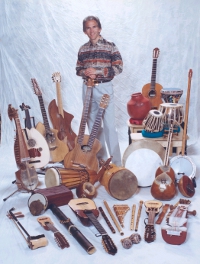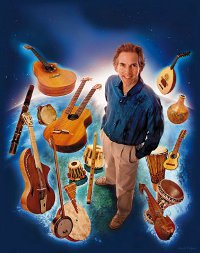 Todd Green, the latest guest in Quad City Arts' Visiting Artist series, began his professional career as a guitarist. Yet the musician knows that whenever he performs at one of his many school engagements, the guitar is perhaps the last instrument the kids will be interested in.
Todd Green, the latest guest in Quad City Arts' Visiting Artist series, began his professional career as a guitarist. Yet the musician knows that whenever he performs at one of his many school engagements, the guitar is perhaps the last instrument the kids will be interested in.
"I have a berimbau," says Green during a recent phone interview, "which is a very unusual, bow-and-arrow-looking thing that you play percussion on. They really like that. And then, you know, there's silly stuff. Like, I have animal toenails, I call them. It's actually goat hooves that are all hooked together and make a percussion sound.
"Usually it's the weirdest ones, you know?" says Green with a laugh. "Especially with the really young kids. You can read their faces - their mouths are open and their eyes are all big - and you can just see them going, 'Whoa. What is this?!'"
To be sure, the sight of someone making music with goat hooves would make many of us exclaim, "What is this?!" But Green's examples here are just three among dozens of instruments that the touring musician performs in concert, and that seem almost designed to make your spell-check explode. The Bolivian zampoña. The Arabic doumbek. The South American walaycho. The Slavic dvoyanka. The Chinese erhu. The Turkish yali tambur.
Some of these - and some two dozen other instruments from around the globe - will be heard when Green, on November 13, presents a public concert at Bettendorf's Redeemer Lutheran Church. And while he's brought with him an intimidating number of musical instruments from his home near Lake Tahoe, Green has not brought along an intimidating number of musicians. Using digital samplers to record himself and create layers of sound, he'll first discuss and demonstrate the instruments, and then perform as a literal one-man band - or, in this case, a literal one-man world-fusion ensemble.
"It's fun," says Green in succinctly describing his unique career. "It's different, that's for sure."
 Freelancing on Everything
Freelancing on Everything
Green, who grew up in New York, says his interest in music began "when I was probably eight or nine. I initially wanted to play drums. But my mother, I guess, decided she didn't want a kid whacking on a snare drum, so she said, 'I don't think so.' And so I said, 'Well, then, I want to play guitar.' So guitar is what it was."
He began taking lessons and, before long, stopped lessons - "Even at that young age," says Green with a laugh, "I had a sense that this teacher I had didn't know what he was doing" - and spent his youth teaching himself to play chords and songs. In the late 1970s, after graduating from high school, Green enrolled in the Berklee College of Music, and he studied privately with noted musicians Mick Goodrich, George Benson, and Grammy Award-winning guitarist Pat Metheny. "I was hardcore jazz ... ," he says. "And it was all guitar at that point."
Following his graduation from Berklee, Green moved to New York City and embarked on a career as a professional guitarist. "I was basically playing jazz," he says, "but kind of freelancing on everything," and his talents led to session work, music for TV commercials, and tours (with several different bands) throughout the United States, Canada, and Europe. ("It's not something I'm proud of," says Green, "but in the early '80s, I was also on some of the first rap records. Which wasn't even called 'rap' then. It was really only a local phenomenon, and I was going to these studios in Brooklyn and doing these recordings.")
Green says, "I eventually got tired of the whole jazz scene in New York. The whole scene period in New York." His disenchantment with the city, though, was also dovetailing with his burgeoning fascination with instruments beyond the guitar.
"New York was where I got more of an interest in Indian music," says Green, who took a class on the subject at Berklee. "I started studying the tablas, which are Indian hand drums, and the bansuri flute, which is the bamboo flute. But I didn't do anything with them. I just studied them and was still just a guitar player. It was when I moved out of New York and moved to Montana, of all places, that I really started exploring them."
Calling Montana "the happy medium" between prospective homes in Colorado ("I thought it had gotten too built up") and Canada ("I didn't want to live in another country"), Green settled in the city of Bozeman in 1988, and says that given his growing interest in instruments from other countries, "I tried to put a group together - a kind of jazz/world-music type of thing. And obviously, there's a limited number of good musicians in Montana compared to New York. But I did find a good bass player, a good percussionist, and a good drummer, so we put a group together, and did a number of concerts all around the region."
Eventually, Green says, the ensemble in which he played guitar "kind of fell apart. But at the same time, these looping digital samplers were starting to come on the market. They were very expensive and they didn't work very well, initially, but I started experimenting with them." He began sampling guitar, flutes, and percussion - getting "a guitar synthesizer to make up for the lack of other instruments" - and finally performed his first one-man-band set at an outdoor concert in Billings, Montana.
"I guess it went all right," says Green, "because I had a lot of people say, 'Man, I've never seen anybody do that before!' And so going in that direction really intrigued me. There were a limited amount of musicians to work with anyway, so I said, 'Well, I might as well do it all myself.'
"So I started exploring more and more instruments," he continues, "and since I was starting to make connections in the [Lake Tahoe] bay area, I eventually moved to the Tahoe area. Just like New York, the bay area has these huge Chinese, Middle Eastern, Indian, and South American communities. And, oddly enough, some of the best musicians in the world - who play instruments from these countries I was interested in - live part-time or full-time in the United States. So I'd basically play with the best players in the world on a lot of these instruments, studying with them and playing gigs with them.
"And," he adds, "it's worked out real nice."
Priority Instruments
Green says that, currently, "I probably play somewhere in the vicinity of 50 different instruments," all of which he owns, though not all of them travel with him from gig to gig. "In the school programs," he says, "I present about 20-something to the kids, and my [public] concerts have maybe 30-something. That's about all I can carry, and really, that's all I have time for in a two-hour concert anyway."
Yet even as the owner of such unique instruments as the African ashiko drums and the stringed, Afghan rabab, Green says it's still easy to pick a favorite.
"Of the 50-ish that I play, if I had to give them all up but one, I'd keep the one I started with - the guitar. That's the one I know the most on. And really, along with the Western violin, guitars are probably the most universal instruments. They're pretty much played in every culture, though they may be played in unusual ways in some cultures. Like in Morocco, they play the Western violin, but they play it in their laps, vertically - not on their neck like we do. And the guitar is played, in some cultures, without the metal frets on it."
Despite his prowess on the guitar, the violin, and all manner of other instruments, Green understands the importance of continual practice.
"I have priority instruments that I work on every day," says Green, "and the guitar is one of them - the variety of guitars, I should say. The pipa, which is the Chinese plucked lute, is one I work on every day. And the bamboo flutes, mainly the bansuri that I started with. But also some of the Middle Eastern neys, they're called - they're end-blown flutes. A few different percussion instruments: the tablas from India, the tonbak from Iran, and the riq, which is a Middle Eastern tambourine. And then the sarangi from India and the kemencheh from Iran. Those are the main ones that I try to work on every day.
"And then I have other ones that, pretty much, I only play when I perform on them," he continues. "You know, they're kind of color instruments. I can do what I want to do on them. I don't have complete mastery or a big repertoire on any of them, but I know what I'm doing on them, and they're easy to play, and I feel very comfortable with them. I never really take them out of their cases except to set them up for the performance and play 'em."
While, as he says, "I'm mostly known for doing this one-man-band thing," Green also does get the chance to perform without the electronic assistance of digital samplers. "Occasionally I do strings-only concerts and guitar concerts," he says. "I have a variety of different, custom-made guitars, so when I say 'guitar concert,' it's not just one guitar. It's maybe a half-dozen that are all unusual-looking, with different kinds of stringing and tuning."
He also frequently performs purely as an acoustic musician during the many school residencies and assemblies at which he's annually booked, engagements that Green says he always looks forward to.
"Yesterday," he says during our October 29 conversation, "a kid came up to me in a high-school program. He played guitar, because he knew about some of the plucking I was doing, and he asked me about the Chinese pipa. He wanted to see up-close how I was doing this technique, which is extremely difficult to learn. And that'll happen, just out of the blue - somebody will come up and say, 'What's that instrument again? Can I see that up close?'
"Every once in a while, I'm totally amazed," says Green of his school appearances. "I did two programs yesterday - one was [grades] K through six, and the other was seven through 12. It was in a huge auditorium with over 500 kids in each one. And it was totally quiet with both groups. They were all just locked in."
 A Pampered Life
A Pampered Life
As you might imagine, though, neither preparing for a concert with dozens of instruments nor traveling to a gig with dozens of instruments is any kind of picnic for Green, who arrives at his venues "six and a half hours before the official concert. I actually do a live prelude ... . A half-hour prelude, mostly with guitar, when they first open the doors. I used to just play a CD, but it's what everybody does, and I kind of like the idea of doing it live. So I need six hours before that." (Green is given something of a break before his school programs, when he only arrives two and a half hours before performances.)
Obviously, Green's preparation requires a great deal of time even before he reaches his venues. "Yeah, packing can be insane," admits the musician. "There's a lot of people who are probably going to bed when I get up. But to be honest with you, the packing has gotten to the point where it's so automatic that I almost don't even think about it anymore."
But after he arrives for concerts, several hours are needed not only for Green to practice on the instruments, but for the instruments themselves to respond to environmental changes from one location to another.
Says Green, "Especially when there are drastic changes - and we're going through that period now, where it's been humid and now it's getting really dry - the instruments need to adjust. And until they adjust, it's a lot of tuning.
"Like right now," says Green of his booking in Minnesota, "I'm dealing with an extremely dry theatre and a humid motel room, which is just the way it is a lot on the road. So I basically carry a dehumidifier and a humidifier with me, so I can regulate the rooms kind of closer to what the theatres are, and the instruments aren't going through as much withdrawal. And I always have to get the van either cooled off or warmed up - I have temperature gauges and humidity gauges everywhere.
"I mean, I'm dealing with all the hassles of the road, and these guys," he says, referring, with tongue in cheek, to his instruments, "they got it good. It's a pampered life on the road here. They only go out of the building when it's the proper temperature in the van. They go into a building, I try to make sure the temperature and humidity is as good as we can get it. They go into a rainy season, I start making it more humid in the motel room. We go into a drier season, I start drying out the room.
"You know, I love sports, and I watch a lot of ESPN, and I'm always hearing these aging athletes who say, 'If I could just do the game and not do all the work around it during the off-season, I'd keep playing. But it's all the other stuff that makes it hard.' And I understand what they're saying, you know? Because if I could just have a crew that would do all the other stuff and I could just show up at the gig? Man, I could do this forever."
Green laughs. "But still. With all the crappy weather, all the problems with tuning, all the schleppin' in and out ... . Once I sit down in front of the kids, or sit down for an evening concert - as soon as I sit down to play - everything else kind of melts away, you know?"
Todd Green will perform a public concert at Bettendorf's Redeemer Lutheran Church (1107 Tanglefoot Lane) on Saturday, November 13, at 7 p.m., and will also perform at the Moline Public Library (3210 41st Street) at 2:30 p.m. on Saturday, November 6. Admission to both events is free, though donations will be accepted.
For more information on Green, visit ToddGreen.com, and for more on his local appearances, call Quad City Arts at (309)793-1213 or visit QuadCityArts.com.










